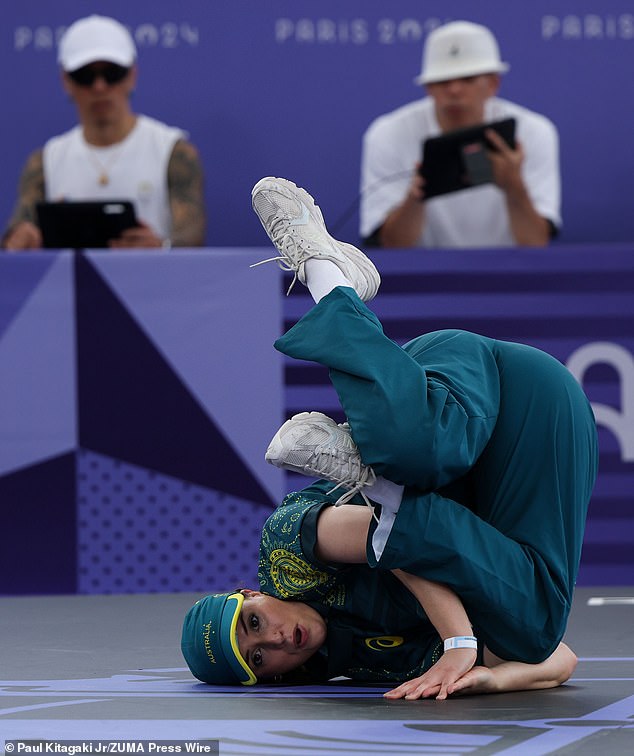Top Aussie breakdancing coach reveals simple fix to stop another Raygun-like embarrassment
- Liam Masters coached Australian male competitor at Paris Games
- Responded to the uproar surrounding Rachael Gunn’s selection
The breakdancing expert who coached Australia’s male competitor at the Paris Olympics has revealed his simple solution to ensuring only the best competitors represent the country after Raygun’s acclaimed performance at the Games.
Rachael Gunn became the biggest news at the Olympics when she failed to score a single point from the judges for her routines, which included impersonating a kangaroo and performing a dance move called the sprinkler.
Her performance made her one of the most famous people in the world, making her the butt of jokes and memes on the internet, but also led to her being offered a surprising job. She stayed in Europe while the rest of the Australian Olympic team returned home on Wednesday.
Now Liam Masters, who coached Jeff ‘J-Attack’ Dunne to become the Australian male boxer in Paris, has weighed in on the controversy surrounding the way Gunn was selected to represent her country in the first place.
“Raygun competed in the Oceania qualifier in Sydney about 10 months ago,” he explained in an Instagram post.
‘She competed and she won. The prize for winning was that she got a spot in the Olympics.
‘I think they need to introduce a qualifying score or a benchmark that is required – and the approval of the jury that this is the level required for international events, such as the Olympic Games.
‘If they don’t meet the standard, or if the score is not good enough, then they will have the opportunity to participate in one of the other qualifying competitions that may be held, to improve their score and prove that they are worthy of a place in the top 16 at the Olympic Games.’
Australian breakdancing coach Liam Masters (pictured) has a simple method to ensure only the best competitors represent the country at future international events

Rachael Gunn (centre) is pictured after winning the Oceania qualifying event, which saw her break through for Australia in Paris.
Masters, who was also candid about the impact the storm over Raygun’s performance had on Dunne, went on to say that the trolling of Gunn “has to stop” because it’s “pathetic.”
He also called on the World Dance Sport Federation to support her as she faces such scrutiny online.
According to Masters, Dunne felt “ridiculously” pressured by the reaction to Raygun’s split just before his participation in Paris.
‘On Saturday [before competing]Jeff woke up and his phone was blowing up… hundreds and hundreds of messages with videos, memes, jokes, trolling, articles [about Gunn]’, said Masters.
‘I really hope the Australian media supports Jeff for his amazing achievement, what he has achieved for his age and what he has overcome.
“It’s a huge achievement to overcome the enormous pressure at the age of 16 with the whole world watching.”
Earlier this week it was revealed that Gunn had predicted what her performance would look like seven years before her performance in France.

Masters wants a benchmark or minimum score introduced for future qualifying events to avoid a repeat of the outcry over Gunn’s routines in France (pictured)
Fans discovered the 36-year-old’s statement on breakdancing, titled: ‘Deterritorializing gender in Sydney’s breakdance scene: a B-girl’s experience of B-boying’.
The dissertation abstract, published in February 2017, predicted Raygun’s iconic routine in Paris.
‘I use analytical auto-ethnography and interviews with scene members in collaboration with theoretical frameworks from Deleuze and Guttari, Butler, Bourdieu and other feminist and post-structuralist philosophers to critically examine how the capacities of bodies are constituted and shaped in the Sydney breakdance scene, as well as to locate the potential for moments of transgression,’ she wrote.
‘In other words, I conceptualize the breaking body not as a ‘body’ composed by rules and assumptions, but as an assemblage open to new rhizomatic connections.’
